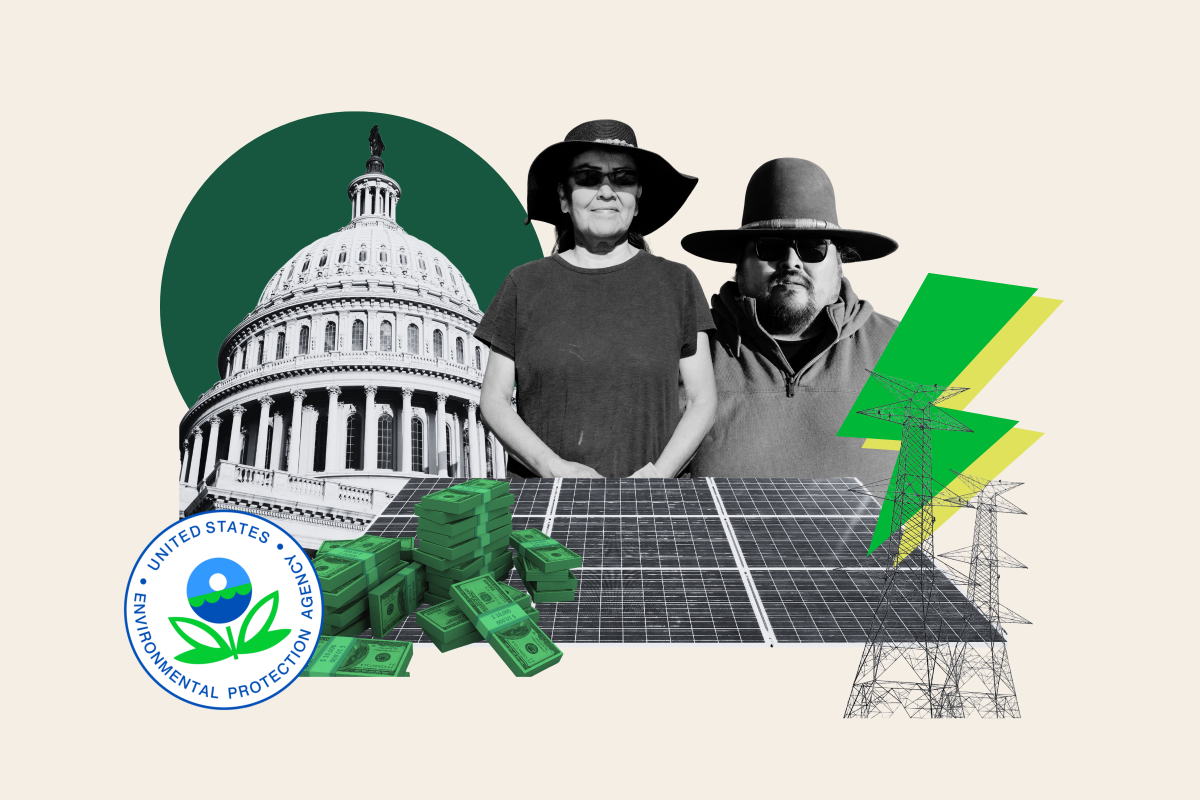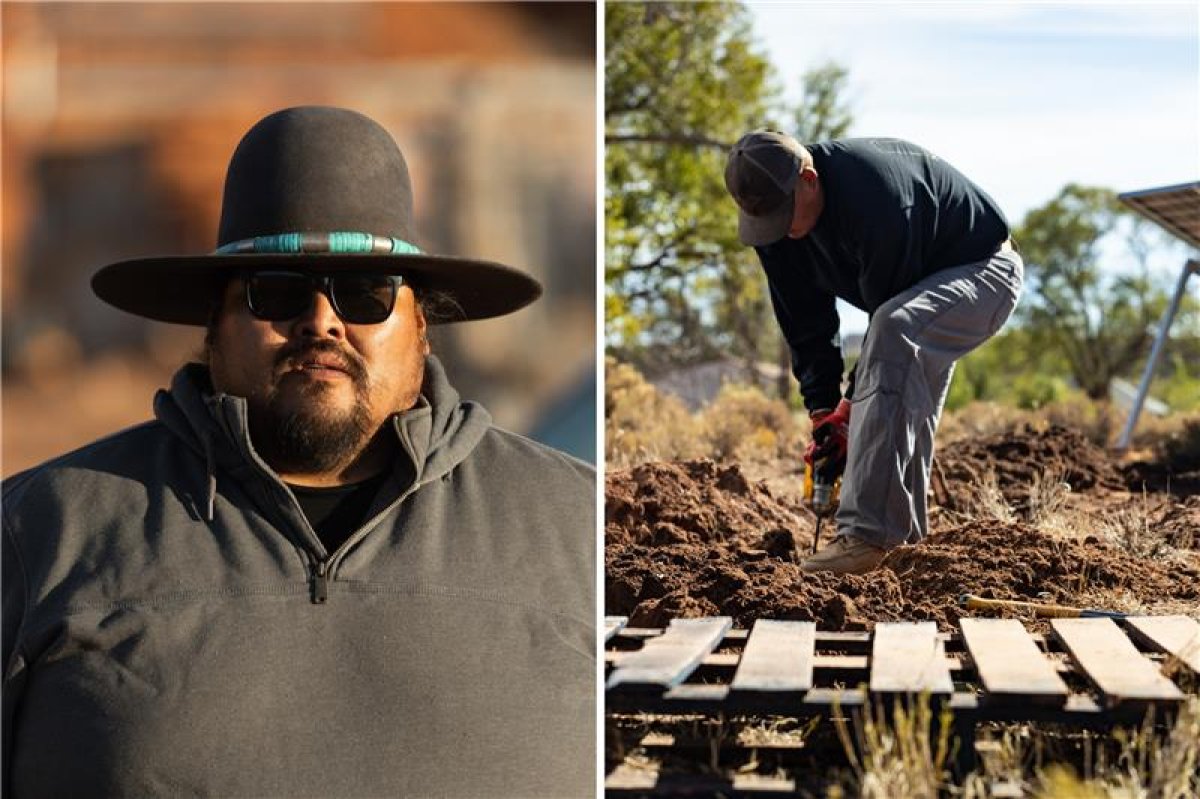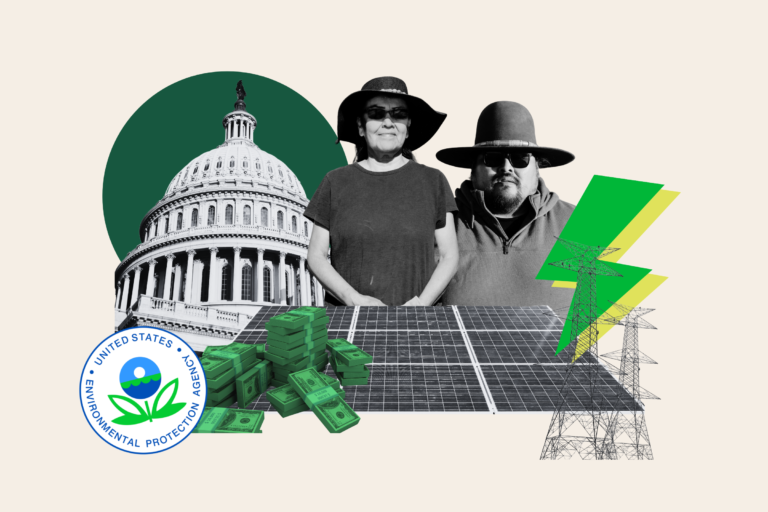The Native American lands in the Four Corners area of America’s Southwest have helped to power the region for decades with coal mines and power plants that produced electricity for booming cities nearby. But the energy most of us take for granted remained out of reach for many of those living on tribal lands.
“You have high-voltage transmission lines going over residences and houses that are still using generators,” Navajo Power Founder and Executive Chairman Brett Isaac told Newsweek. “We’re exporting power, but that infrastructure need never made it to their doorsteps.”
Isaac said an estimated 15,000 homes on the Navajo Nation, where he grew up, lack reliable electricity access, and generators powered by diesel or gasoline can be expensive to operate and highly polluting. Navajo Power aims to provide electricity to more homes by tapping another abundant resource in the Southwest—the sun.

Photo Illustration by Newsweek
Isaac said Navajo Power has installed solar power systems on 320 residences since 2023. Distributed solar allows Navajo Power to bypass the limited the electric distribution system, he said, and he takes pride in creating jobs with American-made energy products.
“We get our panels from Q cells North America, which has a manufacturing plant in Georgia,” he said. “So when we put a panel on the Navajo Nation and power these homes, there’s a ‘Made in America’ sticker on the back of those panels.”
In a rural area with rates of poverty and joblessness well above the national average, few residents could afford to add solar on their own.
“We had to come up with really creative ways to underwrite the way that we finance these,” Isaac explained.
The Greenhouse Gas Reduction Fund (GGRF), established by the Inflation Reduction Act that Congress passed in 2022, aimed to help expand clean energy and efficient appliances to lower income communities.
Through two programs under the GGRF, the Biden administration’s Environmental Protection Agency awarded $20 billion to recipient organizations including Community Development Financial Institutions green banks and nonprofits. The money is meant to leverage other private investment in work like Navajo Power’s solar installations.
With that additional stream of investment, Isaac had set a target to electrify 5,000 homes in the Navajo Nation. But that changed with the arrival of President Donald Trump and his EPA administrator, Lee Zeldin.
Zeldin complained that the GGRF lacked sufficient oversight and called it a “green slush fund.” He pledged to claw back the funding that Congress and his own agency had approved.
By February, recipient groups such as the Climate United Fund, which was laying plans to work with Navajo Power, found that their bank accounts with CitiBank had been frozen. After weeks with no access to their accounts and no explanation for the freeze, the group sued EPA and Citi on March 8.
As U.S. District Court Judge Tanya Chutkan was preparing for a hearing on the case, Zeldin announced he was terminating the funding agreements altogether.
Climate United and some other recipient groups have asked the court for a preliminary injunction to restore their access to the money Congress approved for the program. Chutkan has scheduled another hearing for Wednesday.
As the court considers the case, GGRF-supported projects for health clinics, community centers and homes in tribal communities are in limbo. Isaac said the uncertainty around the GGRF funding makes it difficult for Navajo Power to continue its work.
“We’re still going to keep working on trying to find a solution, but it does definitely make it challenging,” he said.
Climate United said in its court filing that its grant requires it to use about 80 percent of the money on projects in low- and moderate-income communities, rural communities and tribal communities. Because the GGRF was designed to steer investment to disadvantaged areas, the impact of the funding freeze disproportionately affects projects on tribal land and others serving Indigenous communities.
Isaac called that unfair and at odds with the Trump administration’s goal to put “America first.”
“They want Americans to be prioritized in their service, well what about the first Americans, the ones that were here, the indigenous folks?” he asked.

Merci Andrews/Courtesy of Navajo Power
Antony Stately is president and executive officer of the Native American Community Clinic, a federally qualified health care center in Minneapolis, Minnesota.
The clinic is not on tribal land, but Stately said it serves one of the country’s largest and densest populations of urban Native Americans.
Since its establishment more than 20 years ago, the clinic has operated out of converted commercial space in an old strip mall. Stately said his organization had raised money for a new building that included affordable housing units to better fit the clinic’s mission of integrated care to address homelessness and addiction treatment as well as a range of other health services.
“There was a discussion from the very beginning to try and find a way to get to net zero for the building,” Stately told Newsweek. “It’s, I think, part of our Indigenous philosophical ideology to try to be good stewards of the land, take good care of our people and not contribute to waste.”
A financing partnership though the GGRF presented an opportunity to install a geothermal heating system in the new clinic building, Stately said. Not only would that significantly cut the greenhouse gas emissions from the building’s energy use, but the lower energy bills would also save money for both the clinic and those living in its residential units.
“It solves some pretty big challenges for people who have significant poverty and have the highest rates of houselessness and some of the highest rates of poor health outcomes,” Stately said.
With the GGRF funding now in question, Stately said, the new facility will likely have to be built with a conventional heating system instead.
Andreas Karelas, executive director of the nonprofit solar energy developer Re-volv, said the GGRF could “transform the landscape” for nonprofit organizations like the Native American Community Clinic and homeless shelters, food banks, houses of worship and community centers that had a hard time getting financing for solar energy projects.
“The GGRF is a once-in-a-lifetime historic opportunity to solve the climate crisis, to deploy clean energy at the community level and make sure that it’s benefiting everyone,” he said.
Karelas said Re-volv has helped 80 nonprofits go solar in 18 states and every dollar invested has yielded electricity bill savings of $2, money that the organizations can direct to meet their mission instead of paying a utility company.
“The fact that this is being frozen is having massive impacts on not only the recipients and their budgets but also to all of the lenders downstream that were planning on using that capital in their projects,” he said.
Stately said the EPA’s freeze and sudden termination of a program that had promise for tribal communities is, sadly, something he has become accustomed to given the history of broken treaties and agreements between the U.S. and Native governments.
“I think one of the things that we have to ask ourselves is, as American society, is that something we’re OK with?” Stately asked. “You have to find a way to keep your word, I think, that’s a fundamental principle in any society.”


